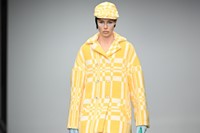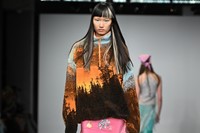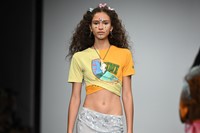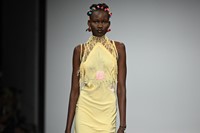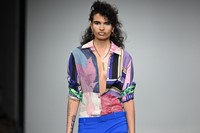The American designer shares the story of his raucous runway debut – a collection that was inspired by the women who shaped his formative years
“I don’t know when we all decided that fashion wasn’t fun anymore,” Conner Ives says in the run up to his London Fashion Week debut, held on Friday in the Newgen space at the Old Selfridges Hotel. “I love colour. I think designers in the 21st century are prone to saying, ‘Oh, I’m a sophisticated designer, I only do, white, black and beige.’ No offence, but that’s so boring.” Fun was the operative word at Ives’ show, which channelled American optimism through 26 fictional characters – each of whom were inspired by women who shaped the designer’s youth in suburban Bedford, upstate New York.
Ives’ route into fashion has been far from orthodox. His wry and subversive namesake brand explores ideas of American identity – a subject brought to focus by a distance the designer felt from home after moving to London to study at Central Saint Martins. But before he’d even graduated, Ives’ career skyrocketed, with retailers such as Browns and Matches eagerly stocking his patchworked T-shirt dresses, and Rihanna scooping him up to be part of Fenty’s in-house design team. His debut show arrives after a momentous first year post graduation – in the past 12 months, Ives has been shortlisted for the LVMH Prize and even had one of his designs exhibited in the Costume Institute’s 2021 show, In America: a Lexicon of Fashion.
Marching out to a pounding mashup of American music – think: y2k anthems like 50 Cent’s Candy Shop blended with 60s songs like Dusty Springfield’s Spooky – Ives’ coterie of Autumn/Winter 2022 characters drew from a tapestry of pop culture references. The opening ‘Vogue Girl’ look was inspired by Andrea Sachs’ (played by Anne Hathaway) glow-up in The Devil Wears Prada, and elsewhere figures were plucked from shows like The Sopranos and America’s Next Top Model. The show also looked to feminine archetypes from Ives’ adolescence like the ‘stay at home mom’, the ‘gap year girl’ and the “hot and cunning” high school ‘VSCO girl’. The collection, says Ives, was a tribute to not only the visual power of these archetypes, but also to his childhood self, for whom these women had sparked a fascination evident in his playful design language today.
Here, speaking in his own words, the American designer talks us through the show:
“The cornerstone of my work is always built around the idea of nostalgia, and this season I’m looking at archetypes of female characters from the y2k era. Some of the references were from shows like America’s Next Top Model, or the ‘Jersey Girl’ character was based on Adriana La Cerva from The Sopranos. For me, these kinds of women have almost become American female icons.
“The ‘Vogue girl’ starts with a really surface reference to Andrea Sachs from The Devil Wears Prada in that wonderful montage where she’s running across the street – you know, she’s had her Vogue girl makeover; she has her gloves on. For me it was just such a feast for the eyes. I think I love playing with those sticky corners that people would almost be afraid of going into. Maybe there’s a fear of it starting to sound trite, but it just had such a resonance with me. I remember being a kid and watching that movie and being like, ‘Oh, my God, whatever they’re doing, I want to do that,’ you know? So it was calling upon those feelings and being like, ‘Can I do something for that kid version of me?’ And that became the goal with it.

“We have one look which I call ‘the spy’, and we felt it would be a disservice to this character to call her like a Bond girl because she’s not a Bond girl, you know, she’s her own person. I’m really interested in these connotations and cultures that we have so deeply rooted in us … There’s one dress that’s in the beginning of the collection – it’s this bias cut scarf dress and it has these flounces at the bottom – and the archetype there was ’the sexy fish’. This is kind of where it gets bigger than American references, but I was thinking of the early y2k Versace girl coming down the runway with an amazing blowout, but then also that same character to be the girl who dines at Sexy Fish [in London] on a Saturday with her girlfriends. She has become a recent favourite.
“One thing I love about American design is just how it can be so many different things – it doesn’t really get the credit that it deserves. American fashion has such a rich history of multiple movements that often get overshadowed by European fashion, like couture in America had a huge moment in the mid-century; you had Charles James, you had Bill Blass, these people that were really making gorgeous clothing and have kind of been forgotten in the history of fashion. So, for me, even just the inspirations this season – this idea of characters – are all disparate, but they all come together in this landscape that I’m creating.

“[The collection] is really this idea of an idealised version of my America. And I’m aware of that conflict there as well. I could make this into an absolutely tragic story, but where’s the hope in that? I love those moments of optimism, and I think that that’s something that’s so evident in American culture, and being in London for the last few years is something I have really longed for.
“I’ve recently realised that this collection was made by me and my friends, and that all the people in my studio day in, day out are anywhere from 21 to 25 [years old]. It’s so impressive to me that this is a 26-look collection made in the last six months by kids. I think it just speaks to when I first entered the industry, when I was 15 or 16, and I really didn’t know what the future held for me, and it felt like the Land of Oz. I try to remember that feeling and, it’s so cliche, try to create that for some kid out there that’s watching the show. For me that’s really become such a driving force – to create something I’m proud of but also that the childhood version of me would die at.”

